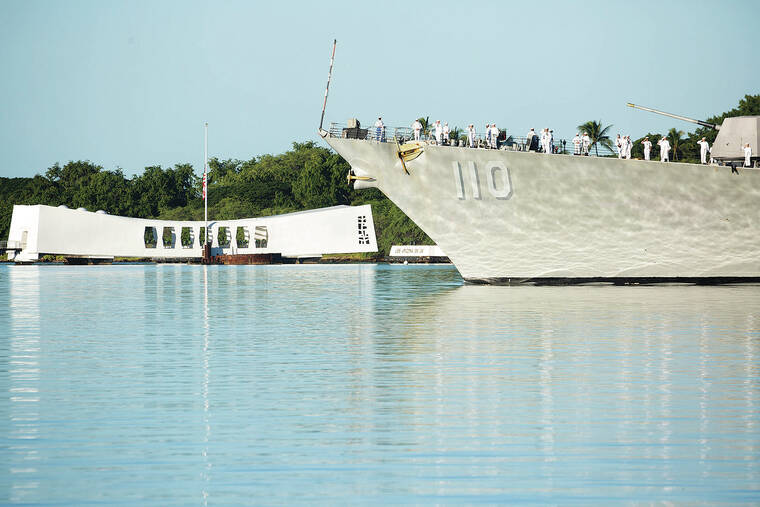Navy in court over Pearl Harbor water contamination
WASHINGTON — Not since the dark day at Pearl Harbor that drew America into World War II has there been so much trouble in paradise.
A gusher of jet fuel that leaked into the base’s drinking water in November 2021 led to a lawsuit that forced the Navy to admit it was negligent in maintaining the gigantic fuel tanks built into a mountain at the start of the war, in a depot known as the Red Hill Bulk Fuel Storage Facility.
ADVERTISING
Now the case, with more than 2,500 plaintiffs so far and about 5,000 more expected to join, is before a federal judge in a trial that started this week in Honolulu to determine the extent of the damages to those exposed to the contaminated water.
The plaintiffs — mostly civilians along with a few hundred military personnel — say the effects were calamitous, with illnesses ranging from nausea and skin rashes to cysts and polyps, as well as serious health problems in their children. Some of the affected families say the impacts have been devastating for their finances and careers, and most say they no longer trust the Navy that has been an iconic presence at Pearl Harbor for more than a century.
“This is a case about a government that poisoned its people,” said Kristina Baehr, attorney for the victims and founder of Just Well Law based in Austin, Texas. “And I don’t use that word lightly. They knew the water was contaminated and let thousands of people get sick.”
After the Nov. 20, 2021, accident that caused about 19,000 gallons of jet fuel to spill into the water supply that serves about 93,000 people at Pearl Harbor, the Navy did not alert residents until many started reporting symptoms such as nausea, vomiting, diarrhea, migraines and lethargy during the long Thanksgiving weekend of Nov. 25-28, according to the lawsuit. Even then, the Navy waited until Dec. 2 — 12 days after the spill — to announce that petroleum products had been found in the water supplies, it said.
Major Amanda Feindt, her husband and two children have all suffered from “debilitating symptoms such as nausea, vomiting, dehydration, diarrhea, migraines, lethargy, and neurological changes,” the lawsuit said. “Their children’s lives have been turned upside down as multiple doctors have tried to explain and treat their symptoms.”
The Freeman family, including an active-duty Navy ensign, “has been plagued with abdominal pain, vomiting, memory loss, skin rashes, brain fog, eye irritation, seizures, and teeth and gum issues because of the fuel leaks caused by the Navy.” Unhappy with the care they were receiving in Hawaii, the family moved to California, where Nastasia Freeman is still battling multiple health problems. “Financially, Nastasia’s work as a therapist has ground to a halt with her family’s medical challenges,” the lawsuit said. “The cost of the move, the house, and the medical procedures has left her family in dire financial straits.”
Jamie Simic, whose husband is a senior chief petty officer in the Navy, was already suffering from a syndrome when she was exposed to the contamination in 2021. She went to the emergency room five times from July to December that year, and doctors said she had cysts on her kidney and breast, a tumor on her ovary and damage to her colon and esophagus that may have been exacerbated by the tainted water. “After dropping below 98 pounds, she began telling her children things they should know if she passed away,” the lawsuit states.
Despite a litany of similar complaints, the Defense Department has argued in legal briefs that the spill was a “nuisance” that might have caused only temporary health problems, and some of those might be “somatic” as a result of stress about the contamination.
“People are still sick and the government is still looking at sick people and saying they’re not sick,” Baehr said.
“They’re claiming there was not enough fuel in the water to make people sick. On the other hand they’re setting up a registry, they’re notifying every doctor in the medical system to look out for symptoms attributable to Red Hill, and they’re acknowledging that there is ongoing neurological harm,” she said. “So how can they do all that in the real world and take a position in the case that there wasn’t enough fuel to make anyone sick and that everyone’s symptoms are psychosomatic? That’s literally the position that they’re taking in the case.”
The Navy did not respond to a request for comment.
“Defueling is not going to solve the entire problem,” said Wayne Tanaka, director of the Sierra Club in Hawaii, which has filed a number of lawsuits citing environmental problems at Red Hill in recent years. He said there are still 4,000 gallons of fuel in the Red Hill pipes, sludge in the tanks — a Navy news report estimates 28,000 gallons — and at least 5,000 gallons of fuel in the aquifer below the site.


